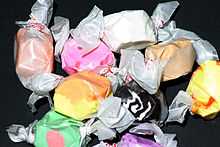Salt water taffy
| Salt Water Taffy | |
|---|---|
|
Salt water taffy with a U.S. quarter | |
| Type | Taffy |
| Place of origin | United States |
| Region or state | Atlantic City, NJ |
| Main ingredients | sugar, cornstarch, corn syrup, glycerine, water, butter, salt, flavoring, food coloring |
|
| |
Salt water taffy is a variety of soft taffy originally produced and marketed in the Atlantic City, New Jersey area starting in the 1880s.[1]
Origins
Candy store owner David Bradley's shop was flooded during a major storm in 1883. As a result of the flood, his entire stock of taffy was soaked with salty Atlantic Ocean water. When a young girl came into his shop and asked if he had any taffy for sale, he is said to have offered some "salt water taffy." At the time it was a joke, because all his taffy had been soaked with salt water, but the girl was delighted. She bought the candy and proudly walked down to the beach to show her friends. Bradley's mother was in the back and heard the exchange. She loved the name, and so salt water taffy was born.[2]

According to Joseph Fralinger,
By 1883, a Mr. David Bradley was advertising 'Taffy' at his stand on the Boardwalk near the David Lindy Baths at St. James Place. He sold six pieces of taffy for 5 cents with each piece folded in a square bit of paper with the four ends twisted together." To Joseph Fralinger's recollection, he was standing at Bradley's booth one day and a little girl asked for 'Salt Water Taffy'. Another asked for 'Ocean Wave Taffy'. Still another asked for 'Sea Foam Taffy'. This caused Fralinger to ask, "How many names have you for that candy?". They answered, "We let them call it any old thing!"
The Taffy
Joseph Fralinger popularized the candy by boxing it and selling it as an Atlantic City. Fralinger's first major competition came from candy maker Enoch James, who refined the recipe, making it less sticky and easier to unwrap. James also cut the candy into bite-sized pieces, and is credited with mechanizing the "pulling" process. Both Fralinger's and James's stores still operate on the Atlantic City boardwalk.
On August 21, 1923, John Edmiston obtained a trademark for the name "salt water taffy" (number 172,016), then demanded royalties from companies using his newly acquired name. He was sued over this demand, and in 1925, the trademark was invalidated as being in common use.
Salt water taffy is still sold widely on the boardwalks in Atlantic City (including shops in existence since the 1800s),[3] nearby island Ocean City, and other popular beaches throughout the United States and Atlantic Canada, as well as in Salt Lake City, Utah. Taffy is also distributed throughout the U.S. to some specialty shops and markets, and other places where an especially wide and diverse variety of candy is sold. It is also available for mail order through Internet sources.
Ingredients
Salt water taffy is composed of sugar, cornstarch, corn syrup, glycerine, water, butter, salt, natural and/or artificial flavor, and food color. Some examples of flavoring include vanilla, lemon, maple, banana, red licorice, watermelon, raspberry or mint extracts.[4] Contrary to popular belief, the taffy contains no salt water (seawater). However, it does contain both salt and water.
Process
Taffy was first cooked in copper kettles over open coal fires, cooled on marble slabs, and pulled on a large hook on the wall. The 'Taffy Pull' was a household enjoyment on Saturday nights as well as an Atlantic City enterprise. Pulling taffy is designed to add air to the corn syrup and sugar confection. By draping 10 to 25 pounds of cooled taffy over the hook and then pulling away from the hook, the taffy stretches. When the taffy reaches a 5- or 6-foot length where it might become too heavy for itself and fall off the hook, the puller loops the taffy back over the hook, folding it onto itself and trapping air between the two lengths of taffy. This process of aeration helps to keep the taffy soft. The pulled taffy was shaped by hand-rolling it on marble or wooden tables into a 1⁄4-inch-diameter (6.4 mm) snake. It was then cut to a 2-inch length with scissors and, finally, wrapped in a pre-cut piece of wax paper with a twist at both ends. All of this was done by hand and usually within the sight of boardwalk strollers. The popular purchase in the 1880s was a 5-cent bag.

References
- ↑ Genovese, Peter. "Chew on this: 125 years later, Jersey Shore still daffy over salt water taffy" in The Newark Star Ledger, August 19, 2013
- ↑ Donohue, Jeanne. "FAMILY / BOARDWALK TRADITION: SALT WATER TAFFY", The Press of Atlantic City, June 8, 2006. Accessed December 19, 2011.
- ↑ Sharkey, Joe (November 11, 2001), "Traces of the place at high tide", The New York Times, retrieved 2011-06-25
- ↑ recipe: Saltwater Taffy. Exploratorium, San Francisco, California, USA
